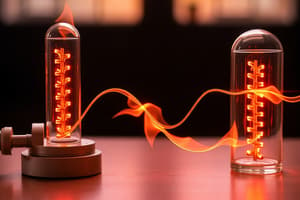Podcast
Questions and Answers
What does the First Law of Thermodynamics state?
What does the First Law of Thermodynamics state?
- Heat can spontaneously flow from cold to hot.
- Energy can be created and destroyed.
- Energy cannot be transformed.
- Energy cannot be created or destroyed, only transformed. (correct)
Which type of thermodynamic process maintains a constant volume?
Which type of thermodynamic process maintains a constant volume?
- Adiabatic
- Isochoric (correct)
- Isobaric
- Isothermal
What happens to the entropy of an isolated system according to the Second Law of Thermodynamics?
What happens to the entropy of an isolated system according to the Second Law of Thermodynamics?
- Entropy is unrelated to heat flow.
- Entropy remains constant.
- Entropy decreases spontaneously.
- Entropy tends to increase. (correct)
How is work done calculated in a constant pressure process?
How is work done calculated in a constant pressure process?
What characterizes an open system in thermodynamics?
What characterizes an open system in thermodynamics?
As temperature approaches absolute zero, what happens to the entropy of a perfect crystal?
As temperature approaches absolute zero, what happens to the entropy of a perfect crystal?
Which statement best describes Carnot's Theorem?
Which statement best describes Carnot's Theorem?
What is the formula for heat transfer based on specific heat capacity?
What is the formula for heat transfer based on specific heat capacity?
What characterizes ionic bonding in inorganic chemistry?
What characterizes ionic bonding in inorganic chemistry?
What is a common characteristic of transition metals?
What is a common characteristic of transition metals?
Which type of inorganic compound is formed from the neutralization reaction of acids and bases?
Which type of inorganic compound is formed from the neutralization reaction of acids and bases?
Which of the following describes ligands in coordination chemistry?
Which of the following describes ligands in coordination chemistry?
In which group of the periodic table would you find alkali metals?
In which group of the periodic table would you find alkali metals?
Which statement best describes a redox reaction?
Which statement best describes a redox reaction?
What describes the coordination number in coordination compounds?
What describes the coordination number in coordination compounds?
Which type of inorganic compound typically consists of a central metal atom bonded to surrounding molecules?
Which type of inorganic compound typically consists of a central metal atom bonded to surrounding molecules?
Flashcards are hidden until you start studying
Study Notes
Thermodynamics Study Notes
Key Concepts
- Thermodynamics: The study of heat, work, and energy transfer.
- System: The part of the universe we focus on; can be open, closed, or isolated.
- Surroundings: Everything outside the system.
Laws of Thermodynamics
- Zeroth Law: If two systems are in thermal equilibrium with a third system, they are in thermal equilibrium with each other.
- First Law (Law of Energy Conservation): Energy cannot be created or destroyed, only transformed.
- Formula: ΔU = Q - W
- ΔU = change in internal energy
- Q = heat added to the system
- W = work done by the system
- Formula: ΔU = Q - W
- Second Law: Heat cannot spontaneously flow from a colder body to a hotter body.
- Introduces the concept of entropy (S), which measures disorder.
- Entropy tends to increase in isolated systems.
- Third Law: As temperature approaches absolute zero, the entropy of a perfect crystal approaches zero.
Key Terms
- Heat (Q): Energy transferred due to temperature difference.
- Work (W): Energy transfer that occurs when a force is applied over a distance.
- Internal Energy (U): Total energy contained within a system.
- Entropy (S): Measure of disorder; higher entropy means more disorder.
Thermodynamic Processes
- Isothermal: Temperature remains constant (ΔT = 0).
- Adiabatic: No heat exchange with surroundings (Q = 0).
- Isobaric: Pressure remains constant (ΔP = 0).
- Isochoric: Volume remains constant (ΔV = 0).
Types of Systems
- Closed System: Can exchange energy but not matter with its surroundings.
- Open System: Can exchange both energy and matter.
- Isolated System: Cannot exchange either energy or matter.
Applications
- Heat Engines: Convert heat energy into work (e.g., car engines, power plants).
- Refrigerators: Transfer heat from a cooler to a warmer area.
- Thermodynamic Cycles: Series of processes that return a system to its initial state (e.g., Carnot cycle).
Important Equations
- Work Done (W):
- For constant pressure: W = PΔV
- Heat Transfer:
- Q = mcΔT
- m = mass
- c = specific heat capacity
- ΔT = change in temperature
- Q = mcΔT
Key Principles
- Carnot's Theorem: No engine operating between two heat reservoirs can be more efficient than a Carnot engine.
- Specific Heat: The amount of heat needed to raise the temperature of a unit mass of a substance by one degree Celsius.
These notes summarize the fundamental concepts and laws of thermodynamics essential for understanding the principles governing heat and energy transfer in physical systems.
Key Concepts
- Thermodynamics studies heat, work, and energy transfer.
- A system is the portion of the universe under study, classified as open, closed, or isolated.
- Surroundings refer to everything outside the system.
Laws of Thermodynamics
- Zeroth Law: Establishes thermal equilibrium; if two systems are in equilibrium with a third, they are in equilibrium with each other.
- First Law: Energy conservation regulates energy transformations.
- Formula: ΔU = Q - W, where:
- ΔU = change in internal energy
- Q = heat added
- W = work done by the system
- Formula: ΔU = Q - W, where:
- Second Law: Heat transfer occurs from hot to cold spontaneously; introduces entropy as a measure of disorder, which increases in isolated systems.
- Third Law: Entropy of a perfect crystal approaches zero at absolute zero temperature.
Key Terms
- Heat (Q): Energy transfer caused by temperature differences.
- Work (W): Energy delivered through force applied over a distance.
- Internal Energy (U): The total energy contained within a system.
- Entropy (S): The quantification of disorder; higher values indicate greater disorder.
Thermodynamic Processes
- Isothermal: Temperature remains unchanged throughout the process (ΔT = 0).
- Adiabatic: No heat transfer occurs (Q = 0).
- Isobaric: Pressure remains stable during the process (ΔP = 0).
- Isochoric: Volume stays constant (ΔV = 0).
Types of Systems
- Closed System: Energy exchange can occur but not matter.
- Open System: Allows for exchange of both energy and matter.
- Isolated System: No exchange of energy or matter with surroundings.
Applications
- Heat Engines: Devices that convert heat energy into work, such as car engines and power plants.
- Refrigerators: Equipments that transfer heat from cooler to warmer regions.
- Thermodynamic Cycles: Sequences of processes that return a system to its original state, exemplified by the Carnot cycle.
Important Equations
- Work Done (W): For processes under constant pressure, W = PΔV.
- Heat Transfer (Q): Calculated using Q = mcΔT, where:
- m = mass
- c = specific heat capacity
- ΔT = change in temperature
Key Principles
- Carnot's Theorem: Sets an upper efficiency limit for engines operating between two heat reservoirs.
- Specific Heat: Defines the heat required to raise a unit mass of a substance by one degree Celsius.
Inorganic Chemistry Overview
- Focuses on inorganic compounds such as metals, minerals, and organometallic substances.
- Distinct from organic chemistry, which involves carbon-based compounds.
Key Concepts
- Elements and Compounds: Investigates properties and interactions of elements and their compounds.
- Periodic Table: Organizes elements into groups (columns) and periods (rows) to elucidate chemical behavior.
- Bonding:
- Ionic Bonding: Involves electron transfer leading to charged ions.
- Covalent Bonding: Entails sharing of electron pairs between atoms.
- Metallic Bonding: Features delocalized electrons in a metal cation lattice.
Types of Inorganic Compounds
- Salts: Result from acid-base neutralization, comprising cations and anions.
- Oxides: Created when elements react with oxygen.
- Acids and Bases:
- Acids: Electron pair donors, e.g., HCl, H2SO4.
- Bases: Proton acceptors or hydroxide donors, e.g., NaOH, Ca(OH)2.
- Coordination Compounds: Consist of a metal center surrounded by ligands (electron pair donors).
Coordination Chemistry
- Ligands: Molecules/ions donating electron pairs, examples include NH3 and CN⁻.
- Coordination Number: Represents the number of ligands attached to a central atom, commonly 2, 4, or 6.
- Isomerism: Geometric and stereoisomerism occurs due to different ligand arrangements around the metal.
Transition Metals
- Located in groups 3-12 of the periodic table.
- Features include variable oxidation states, colored compounds, catalytic activity, and complex formation.
Main Group Elements
- Group 1 (Alkali Metals): Highly reactive, soft metals (e.g., Li, Na).
- Group 2 (Alkaline Earth Metals): Reactive but less than alkali (e.g., Mg, Ca).
- Groups 13-18: Encompass metalloids and nonmetals, crucial for understanding acidity, basicity, and reactivity.
Inorganic Reactions
- Redox Reactions: Entail electron transfer through oxidation and reduction.
- Acid-Base Reactions: Characterized by proton transfer.
- Precipitation Reactions: Lead to solid formation from solution during reactions.
Applications of Inorganic Chemistry
- Utilized as catalysts in industrial processes, such as ammonia synthesis via the Haber process.
- Relevant in materials science for products like ceramics and magnets.
- Important for biological functions, such as metal ions in enzymatic processes.
- Plays a role in environmental chemistry for pollution control and remediation efforts.
Experimental Techniques
- Spectroscopy: Evaluates the interaction between light and matter to infer structural characteristics.
- X-ray Crystallography: Identifies atomic arrangement in crystalline materials.
- Titration: Quantitatively determines the concentration of unknown solutions.
Safety and Handling
- Recognizes the potential toxicity and reactivity of various inorganic compounds, especially heavy metals.
- Emphasizes adherence to lab safety protocols when handling inorganic substances.
Studying That Suits You
Use AI to generate personalized quizzes and flashcards to suit your learning preferences.




